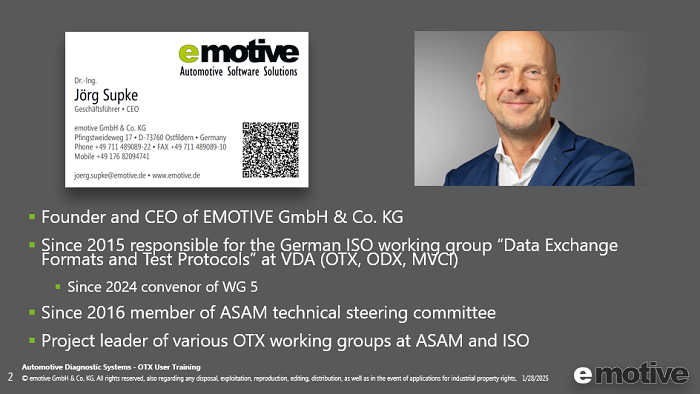 |
OTX Reference
|
|
 |
OTX Reference
|
|
The desire for greater safety, comfort and energy efficiency can only be achieved by a variety of highly networked electronic vehicle systems today. Conclusion: The proportion of electronics and software in the vehicle is constantly growing. The electronics in the car now makes up around a third of the vehicle's value. Mastering the complexity of the entire vehicle life cycle with a simultaneous reduction in costs is therefore one of the key challenges of automotive electronics. The modern vehicle diagnosis plays a crucial role: To ensure the operability, each function must be tested. This huge challenge can only be mastered by new technologies, standards, and the support by appropriate software tools.
The training gives an overall overview and foundations of OTX for further in-depth knowledge. It provides a comprehensive and systematic overview of the exchange format for test sequences OTX (ISO 13209). The participants get to know the structure and handling of OTX data as well as the possibilities and limits of the standard. The contents are illustrated and consolidated through practical examples and live demonstrations.
The objective is primarily about understanding and being able to use OTX:
Important: The theory must be applied. The training can only be a basis for further in-depth practical application!
The seminar is intended for engineers in the automotive and supplier industry who want to become familiar with exchange format OTX. General knowledge about the fundamentals of vehicle diagnostics and diagnostic processes is recommended.
Dr.-Ing. Jörg Supke studied Mechatronics and received his PhD in Automotive Engineering at the Technical University of Darmstadt. In 2008, he founded EMOTIVE. He is a member of ASAM Technical Steering Committee and the convenor of the working group "Data Exchange Formats" at ISO. The working group covers the standards OTX, ODX and MVCI. He is the project leader of the working group “ASAM OTX Extensions” and other working groups for OTX at ASAM and ISO.

The training lasts two days with 6 hours of training per day. The training is carried out in-house at the customer's premises. Including breaks, a time of 9:00 a.m. to 5:00 p.m. with a lunch break of 1.5 hours is suggested. If required, the training can be extended to include a workshop for in-depth study or consulting on individual solutions.
For the application of OTX in the process, the training is structured according to the following roles:
The training is modular in structure so that the different roles are covered, starting with the role of the "Checker". Es wird zwischen der Theorie und Übungen mit der Open Test Framework gewechselt, welche die Theorie anwenden und Abwechslung bringen sollen.
Each seminar participant will receive training materials in digital form (PDF format) as well as a 30-day evaluation license of Open Test Framework.
An example of the training material (slides 1 to 43 of 247):